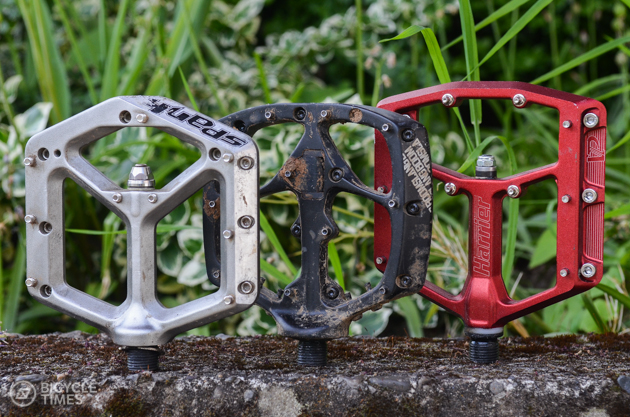Recommendo: Flat pedals for touring and bikepacking
Originally posted on April 29, 2015 at 15:40 pm
Like many gear-oriented guys I know, when I first got into cycling I went all in. I bought the spandex shorts, the fingerless gloves, and of course, those wacky clip-in pedals. But now that I’m a little older and wiser, or at least a lot more pragmatic, I’ve taken a shine to flat pedals for touring and bikepacking adventures.
I think about it this way: when I’m out and about exploring, ultimate power transfer to the pedals isn’t my top priority. I would gladly trade a few watts for the ability to get off my bike and explore a waterfall, drop into a cafe or set up camp without having to walk in clipless shoes or carry an extra pair.
So flat pedals it is, but I’m certainly not going to ride on the freebie plastic things that are probably going to snap in half in the middle of nowhere. Luckily high quality options abound, thanks to mountain bike riders and their durability requirements. These three pedals are designed largely for aggressive mountain bike riding, but I’ve borrowed them for a bit from our sister magazine, Dirt Rag, for use on road and off-road adventures.

Spank Spike – $130
These are the pedals that kindled my love for high-end flats. They have a huge platform and look great. The three-quarter axle is hollow tapered steel with a bushing on the outboard side and a sealed bearing on the inboard side. While the big inboard bearing keeps things spinning nicely, it isn’t big enough to cause any annoying run on the instep of your foot. I measured the spread of the pins—where you’re feet actually make contact— with my Feedback Sports calipers and it is approximately 100 mm front to back and 102 mm side to side.

The lack of a pedal wrench spot on the axle also means the Q-factor is kept narrow. The aluminum body is available in six colors and the 20 pins thread in from the opposite side for easy replacement or adjustment. The body is essentially flat and measured just more than 12 mm thick. The Spikes weigh in at 439 grams per pair, and like each of the pedals in this group they are completely serviceable and rebuildable.

Specialized Boomslang – $180
Years in the making, the Boomslang pedals are typical of Specialized products in that they are high tech and sleek. The aluminum body is all swoops and curves and has a slightly concave shape I measured at more than 13 mm at the edges and 11 mm at the inside. Rather than use an outboard bushing it uses a unique design in that the outer needle bearing is accessed through a little trap door held in place by the pins. The inner bearing is a standard, sealed radial unit.

Each pedals has 22 pins with an hourglass shape that allows them to snap off in a controlled manner. If they do, there are four extras threaded into each pedal on the side. I measured their spread at 90 mm front to back and 105 mm side to side. The Boomslang pedals are a bit smaller and feel a bit thicker than the others in this group, perhaps because of the height of the pins. Some drawbacks are that they require a special spanner tool to access the inner bearing and the middle pins cannot be removed because they hold the door to the outer bearing in place. Like Henry Ford’s finest, they’re only available only in black.

VP Harrier – $120
I thought the Spike and Boomslang pedals were big until I saw the Harriers. These things are HUGE. They use a chromoly axle and an outboard bushing, but the inner bearing is an Igus polymer bearing which is much smaller and thinner than a sealed radial bearing. This means there barely bulge at all where the axle meets the crank arm.

Each pedal has six pins per side that thread in from the opposite side, plus four pointy pins that use a standard box wrench. I measured the pins at 91 mm front to rear and 107 mm side to side. The squared off shape of the body maximizes real estate, something I appreciate when riding in boots. In addition to this deep red they’re also available in black or silver.
Conclusion
All of these pedals are high-end offerings designed to be battered on trails and ridden hard, so I have no doubt they are all plenty durable enough for touring. The VP Harriers get my vote because of their huge platform, lower weight and simplified bearing design. Plus they’re the least expensive in this group.
What kind of pedals do you use for touring?